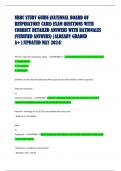NBRC STUDY GUIDE (NATIONAL BOARD OF RESPIRATORY CARE) EXAM QUESTIONS WITH CORRECT DETAILED ANSWERS WITH RATIONALES (VERIFIED ANSWERS) |ALREADY GRADED A+||UPDATED MAY 2024! The four steps for respirat ory mgmt - <<ANSWERS>>1. tx *ventilation *first (should problem exist) 2. *oxygenation* 3. *circulation* 4. *perfusion* problems at one step will adversely affect each process that follows it within sequence External respiration vs. Internal respiration - <<ANSWERS>> External = exchange of O2 and CO2 across AC membrane - depends on diffusion capacity of AC membrane & ventilation Internal = exchange of O2 & CO2 across blood and tissue cells - depends on circulation Signs vs. Symptoms - <<ANSWERS>>* Signs = Objective information*; can be seen, measured, heard, or felt - Color, pulse, edema *Symptoms = Subjective information* - Dyspnea, pain, nausea Steps in Assessment: - <<ANSWERS>>1. *Visual examination * - General appearance, sensoru m, chest movement, posture, skin color 2. *Bedside exam* - BS, VS, auscultate, percussion, PMH, cap refill 3. *Lab exam * - ABG, CBC, CXR, lytes 4. *Specials* - urinalysis, gram stain, MIP, VC Skin Appearance - color - condition - <<ANSWERS>> - *Normal:* Race specific - *Decrease in color* = ashen, pallor → anemia, blood loss - *Jaundice: *↑ bilirubin levels → liver failure - *Erythema: *Redness of the skin → *hypercarbia, COHb, inflammation* - *Cyanosis: *Bluish → Hypoxia (this is a poor asses sment of hypoxia bc it shows up late! Only appears after 5 gram% of Hb is desaturated...) - *diaphroesis:* sweating - *turgor*: slowed response shows dehydration → either through hypernatremia or/and hypovolemia Smoking history - Calculating Pack -year - Verifying if pt is compliant w/smoking cessation program - <<ANSWERS >>Pack Years = *(packs per day) x (# years smoked)* Measure pt's COHb to see if they actually are quitting smoking COHb be levels should ↓ from their baseline to non -smoking normals of < 1% Terms for Describing Sensorium/Neuro (LOC) - Conscious - Confused - Disoriented - Lethargic - Obtunded - Stuporous - Comatose - <<ANSWERS>> - *Conscious*: alert to time, place, and person; responds appropriately -* Confused: *can't think clearly, respon ds inappropriately -* Disoriented: *disoriented to time/place; starting loss of conscience -* Lethargic: *sleepy, but will wake; still oriented (can be early sign of increased ICP) -* Obtunded:*hard to wake; slowed response but appropriate - *Stuporous: *doesn't awaken completely; only responds to painful stimuli - *Comatose*: unconscious; doesn't respond to any stimuli Glasgow Coma Scale (GCS) - <<ANSWERS >>To measure level of consciousness (LOC) *Eye opening:* spontaneous 4, in response t o voice 3, respond to pain 2, none 1 *Verbal response:* oriented 5, confused 4, inappropriate words 3, incomprehensible words 2, none 1 *Motor response:* obeys commands 6, localizes 5, withdraws 4, flexes (decorticate) 3, extends (decerebrate) 2, none 1 • > 13 minor impairment • 9-12 moderate impairment • < 8 severe impairment iatrogenic - <<ANSWERS>>of or relating to illness caused by medical examination or treatment Jugular Vein Distension (JVD) - <<ANSWERS>> - Occurs with *CHF and pneumothorax* - most commonly bc of right vent fail due to chronic hypoxemia and CHF pleurodesis - <<ANSWERS>> pleural space is artificially obliterated - requires a hemostat, and 3 way stop cock macroglossia - <<ANSWERS>> swelling or enlargement of the tongue - bc of trauma, or congenital (ie Down's Syndrome) Orthopnea - <<ANSWERS>> Difficulty breathing except in the upright position - can relate to CHF tracheal shift - causes - <<ANSWERS>> Toward abnormality: - pneumonectomy (lung removal) - atelectasis - lung collapse - unilateral diaphragmatic paralysis Away from abnormality: - pneumothorax - hemothorax - pleural effusion - lung tumor - neck tumor - diaphragmatic hernia Pulsus paradoxus vs. Pulsus alterans - <<ANSWERS>>* Pulsus paradoxus: *Significant reduction in pul se strength during inhalation by 10+ BPM - could be bc status asthmaticus causing air trapping *Pulsus alterans: *Succession of strong and weak pulses, but rate doesn't change - could be due to MI or CHF




